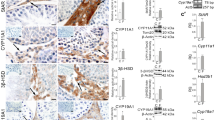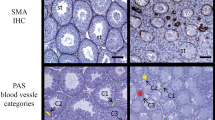Abstract
GROUPS of Leydig cells have been found in the spermatic cords in 23 of 30 consecutive necropsies. The groups of Leydig cells most commonly occur in the 3 cm. of cord immediately above the upper pole of the testes, but they may be found up to 10 cm. above the globus major, with considerable variation in distribution, both in numbers present and numbers of levels. The cells are constantly distributed in the loose areolar tissue around nerve sheaths and usually infiltrate the nerve bundle, disorganizing the characteristic wavy pattern of nerve fibres. Such cells show all the morphological features characteristic of Leydig cells, crystalloids of Reinke and hyaline bodies occasionally being evident. Infiltration of the nerves by Leydig cells has been described, but not explained, by various authors1–4. Some thirty years ago this peculiar association occasioned discussion as to the nature of the cells5,6. The relation to nerves can be accounted for either (a) by migration along nerve fibres at the embryonic period when nerve fibres grow into testicular parenchyma, or (b) by traction of cells from the formed parenchyma during descent of the testicle. The first explanation can be discounted by the similarity of the trabecular pattern of capillaries in normal nerves and the trabecular pattern shown by the infiltrative cells before their continued proliferation disrupts the organized appearance of the nerve.
This is a preview of subscription content, access via your institution
Access options
Subscribe to this journal
Receive 51 print issues and online access
$199.00 per year
only $3.90 per issue
Buy this article
- Purchase on Springer Link
- Instant access to full article PDF
Prices may be subject to local taxes which are calculated during checkout
Similar content being viewed by others
References
Nelson, A. A., Amer. J. Path., 14, 831 (1938).
Sternberg, W. H., Amer. J. Path., 25, 493 (1949).
Okkels, H., and Sand, K., J. Endocrinol., 2, 38 (1940).
Warren, S., and Olshausen, K. W., Amer. J. Path., 19, 307 (1943).
Brannen, D., Amer. J. Path., 3, 343 (1927).
Berger, L., C.R. Acad. Sci., Paris, 175, 907 (1922).
Berry, R., et al., Angiology, 10, 372 (1959).
Author information
Authors and Affiliations
Rights and permissions
About this article
Cite this article
HALLEY, J. Relation of Leydig Cells in the Human Testicle to the Tubules and Testicular Function. Nature 185, 865–866 (1960). https://doi.org/10.1038/185865a0
Issue Date:
DOI: https://doi.org/10.1038/185865a0
This article is cited by
-
Extraparenchymal ovarian and testicular Leydig cells: ectopic/heterotopic or orthotopic?
Archives of Gynecology and Obstetrics (2018)
-
Postnatal development of the vascular supply of the human testis
Zeitschrift f�r Anatomie und Entwicklungsgeschichte (1971)
-
An angiographic study of the testicular vasculature in the postnatal rat
Zeitschrift f�r Anatomie und Entwicklungsgeschichte (1967)
Comments
By submitting a comment you agree to abide by our Terms and Community Guidelines. If you find something abusive or that does not comply with our terms or guidelines please flag it as inappropriate.



